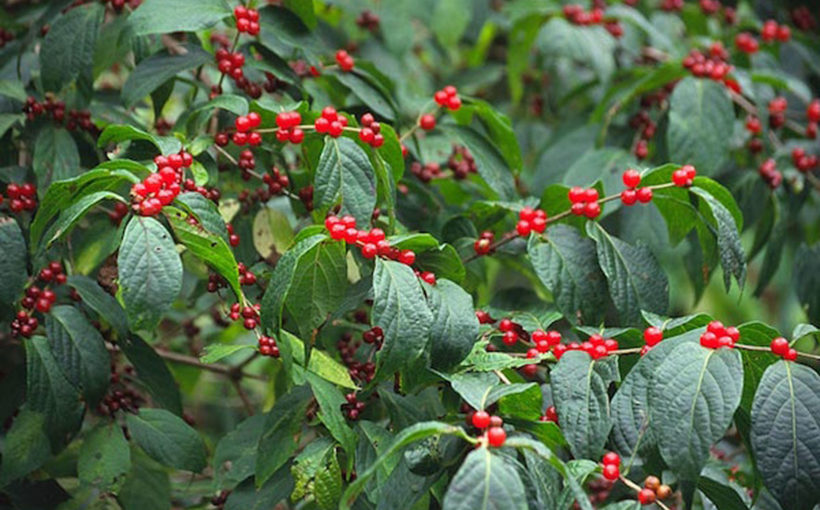Do you have shrubs that sprang up out of nowhere, or a stand of weeds you just can’t get rid of? Chances are, you have invasive plants.
Invasives are non-native plants that spread aggressively outside their native range. They outcompete native plants and well-behaved non-natives, destroying ecosystems in the process. Many enter the U.S. as ornamental garden plants, only to escape into the wild and start wreaking havoc.

Controlling Invasives with Integrated Pest Management
We remove and control invasive species in outdoor spaces through integrated pest management, which means using the least dramatic intervention necessary to get results. That can look like:
- Mechanical removal of plants (hand weeding).
- Ensuring existing invasives don’t go to seed.
- Repeated mowing or string trimming to prevent invasives from spreading and weaken them over time.
- Careful, targeted use of pesticides for plants that do not respond to mechanical intervention.
- Immediately planting or covering spaces where invasives are removed to hold the ground.
Controlling invasive plants requires a long-term strategy! Contact us to identify your invasive species, create a control program for you, treat or mechanically remove them from your outdoor space, and plan a planting strategy to keep invasives at bay.
Invasives Common to Central Indiana
To find a list of invasive plants in your area, start with the National Invasive Species Information Center. Then try searching your state with the term invasive species list. For Indiana, you can find a list from the Indiana Invasive Species Council here.
We’ve highlighted invasives you’re most likely to find in Indiana gardens; you can see more on our invasives Pinterest board.
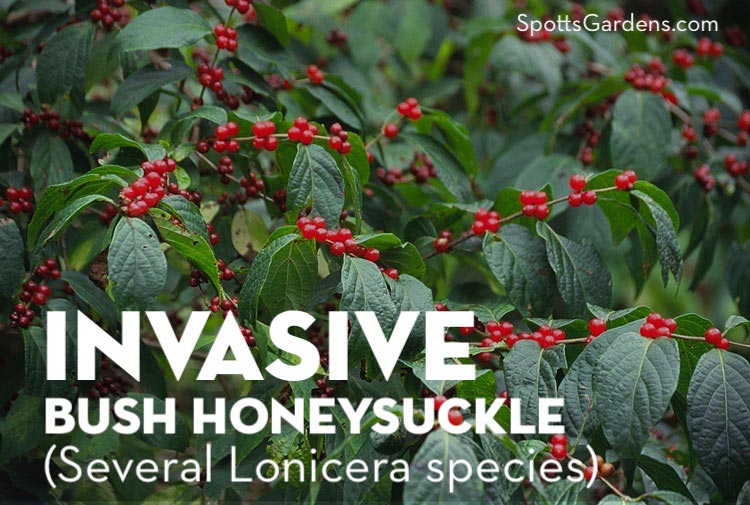
Asian Bush Honeysuckle (Lonicera spp.)
These Asian natives do serious damage to wild areas, and we can guarantee that they’re in your neighborhood gardens, too. Lonicera japonica, L. maackii, L. morrowii, L. tartarica, and L. x bella are all classified as highly invasive. They grow at an astounding rate. And because birds love the berries, they are widely distributed. Fortunately, Indiana nurseries are not permitted to sell any of these species.
To manage bush honeysuckle:
- Dig shrubs out completely with a mattock.
- If you can’t do that, use the cut-stump method. Cut the shrub down to a few inches tall, then paint the fresh cut with glyphosate (41% glyphosate mixed 1:1 with water; see this extension article for specifics).
- Patrol carefully for regrowth and repeat removal or cut-stump method as necessary.
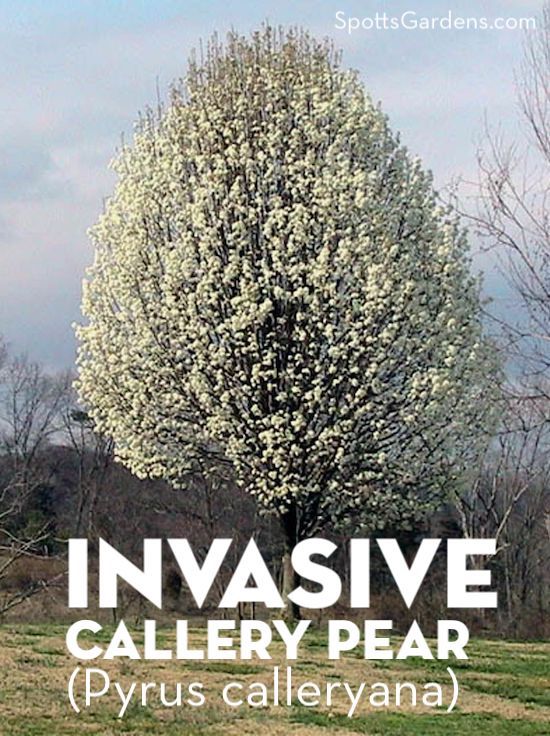
Callery Pear (Pyrus calleryana)
Go to virtually any recently completed housing development, and you’ll see streets lined with the pyramidal shapes of young Callery pears. Bad call. These trees grow quickly, but they are short-lived. Also, they are prone to splitting, stinky when blooming, and now classified as highly invasive.
While the fruits of Callery pear cultivars (like Bradford pear) may be sterile, they can cross-pollinate with other kinds of Callery pears, resulting in hybrids that create large, invasive colonies in natural areas.
To manage Callery pear:
- No matter how pretty it is, do not buy a Callery pear.
- If it’s feasible, cut down and stump-grind your pear tree. Alternatively, wait for your existing tree to die or fall over, and replace it with a native tree like a serviceberry (Amelanchier spp.) or redbud (Cercis canadensis).
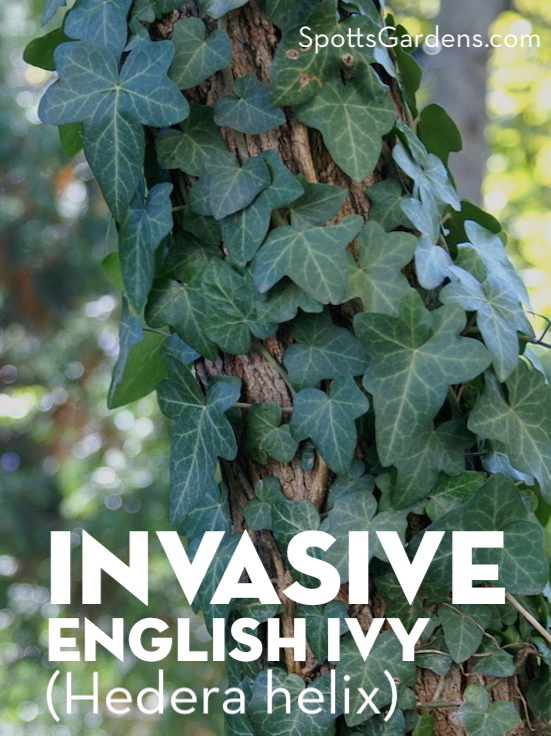
English Ivy (Hedera helix)
The boa constrictor of plants, English ivy can climb trees up to 90 feet high and kill them by completely smothering them—trunk, branches, and twigs. It is classified as moderately invasive.
Ivy grows in two stages. In its juvenile, vegetative stage, it mostly grows along the ground, then goes vertical when it encounters an upright obstacle. It reproduces by sending out stolen to expand its footprint. In the mature, fruiting stage, it flowers and sets seed. Most fruiting happens at the top of vertical vines, but ivy can also flower on prostrate patches of old growth.
To manage English ivy:
- Because ivy flowers on vertical growth, keep it from climbing trees and buildings. Cut through vines at the base of trees and walls and then cut them again at about shoulder height. If you can remove the cut sections without pulling bark off the tree, do so.
- Creating a clear ring around the base of trees and a space between the bottom of walls and the ivy will help keep these vertical surfaces clear.
- To contain ivy, regularly trim and edge it. Run the lawn mower next to it regularly to keep it from expanding into the lawn.
- For small patches, you can remove ivy mechanically, the same way you would eliminate wintercreeper (see below). For more extensive infestations, a foliar application of 3% glyphosate is more cost effective (see this extension link for more).
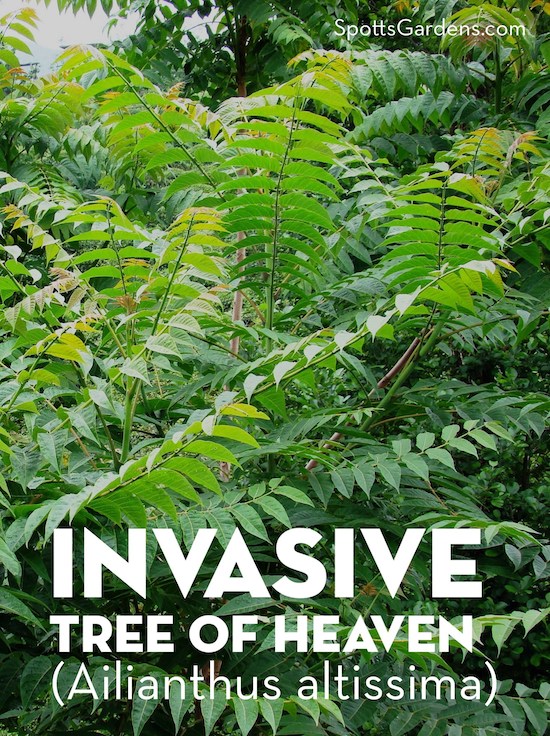
Tree of Heaven (Ailanthus altissima)
A native of China, this reeking tree grows extremely quickly. Tree of heaven changes the soil it grows in, and it can actually kill other plants near it. It smells like rancid peanut butter. And it’s a host plant for invasive spotted lanternfly. Indiana nurseries are not allowed to sell it.
Tree of heaven is particularly difficult to eradicate. If you simply cut it, it will send up a huge number of suckers.
To manage tree of heaven:
- Dig out small starts as soon as you see them, attempting to get all of the roots.
- Established tree of heaven is best treated by a professional using triclopyr. It often requires repeated treatments.
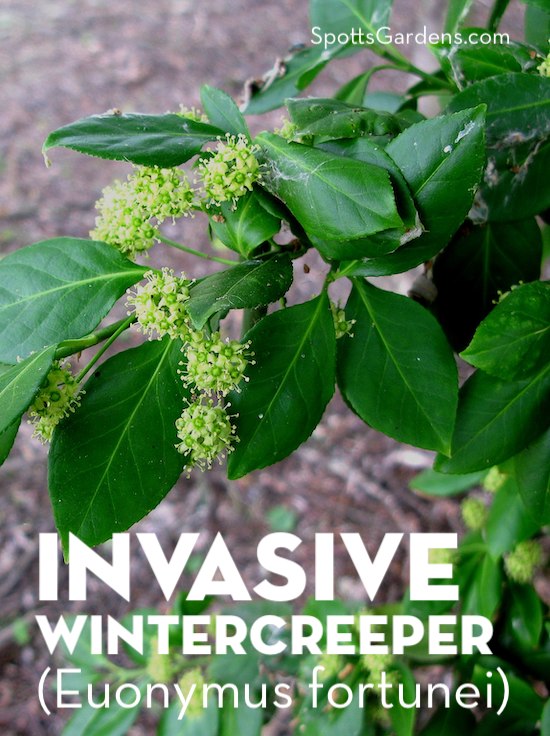
Wintercreeper (Euonymus fortunei)
Wintercreeper has been a popular garden plant for years. Its shiny, evergreen leaves make it a popular ground cover that grows quickly; it puts down roots wherever the stems touch the soil. However, it eventually smothers all plants in the vicinity, covers trees, and possibly consumes slow-moving pets.
Wintercreeper is classified as highly invasive. It’s illegal for Indiana nurseries to sell it.
Like ivy, euonymus reproduces when it goes vertical. So prevent it from climbing trees and buildings to keep it in its vegetative stage instead of its fruiting stage.
To manage wintercreeper:
- To contain wintercreeper, regularly trim and edge it. Run the lawn mower next to it regularly to keep it from expanding into the lawn.
- Cut euonymus stems off of trees as described above under ivy.
- To mechanically remove winter creeper, string trim (weed whack) the top growth, then rake out the roots. Repeat until you have completely removed the roots, then patrol for future resurgence. Alternatively, cut at the soil line and roll the entangled vines backward as if rolling up sod.
- Chemical control is best done by a professional using triclopyr.
Ready to take your landscape back from invasive plants? Contact Spotts Garden Service for a free estimate!
